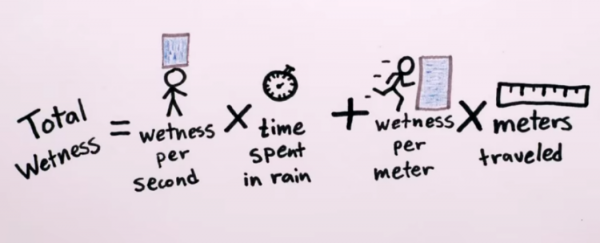When you're stuck in the rain with no umbrella, raincoat, or strange protective forcefield of air, should you tell yourself "It's just water!", and resign yourself to a brisk walk, or should you sprint your way to the warmth and sweet, sweet dryness of home? Walking means you're going to spend more time getting wet, and running means you'll spend less time getting wet, but logic suggests that when you run, you'll also get hit by more raindrops from the side. So which option is better?
Based on a study published in the European Journal of Physics in 2012, Henry Reich explains in the episode of MinutePhysics above, as you walk out of the way of one raindrop, you're moving into the path of another one. This means the amount of rain that's hitting the top of you is constant, regardless of how fast you're going.
"You can picture that the raindrops themselves are stationary, and you - and the Earth below you - are moving upwards through the rain," says Henry. "And since the volume of a parallelepiped - a 3D parallelogram - doesn't depend at all on its slant, then no matter how fast you're moving horizontally, the same amount of rain will land on top of you each second." Which sounds like a pretty obscure comparison, but when you see it illustrated, it makes a lot of sense.
This means that if you're not moving, the rain that's falling on top of you is all you'll get. But when you start moving, you'll also come into contact with raindrops from the side. So really, if you want to stay driest, you should just stand still, in the middle of the rain. Of course, this isn't exactly practical, and people will probably drive past and think you've gone mad. So you have to move, and just like how a snowplough will drive away the fallen snow in its path no matter how fast it's going, the amount of rain you'll come into contact with, whether you walk or run, will actually be the same. Because, again, parallelepipeds.
"Over a given period of time, the same amount of rain will hit you from the top, regardless of how fast you're going," says Henry. "And over a given distance, you'll hit the same amount of rain from the side, again, regardless of how fast you're going."
He then hits us with an amazing equation that shows when you're moving, time spent in the rain is actually the determining factor when it comes to total wetness. So, according to MinutePhysics, you should minimise this by running like a person in the rain without a raincoat.
Case closed? Well, not quite, because the guys at Myth Busters have their own take on this conundrum:
Who would have thought such a simple question - walk or run? - could be so incredidbly complex to answer. But we have an answer of our own, and that's to take advantage of the modern techology that created tiny umbrellas the size of your hand and just put one in your bag and leave it there. Problem solved.
Source: MinutePhysics
